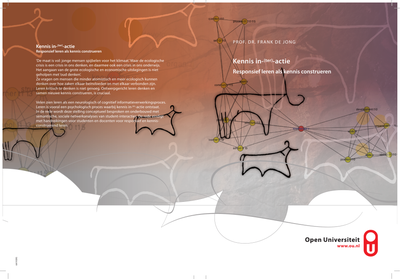Artikel dat een stand van zaken geeft van (onderzoek naar en implementatie van) semantisch grammaticaonderwijs in het voortgezet onderwijs. Tevens wordt in dit artikel ingegaan op de semantische benadering van voorzetsels. Dit artikel vormt achtergrondinformatie bij de workshop die ik op 29-11-2013 op de HSN-conferentie op de Hogeschool van Utrecht heb gegeven.
MULTIFILE

Artikel waarin kort geschetst wordt op welke wijze semantisch georiënteerd grammaticaonderwijs op het v.o. gebruikt kan worden. Beknopte achtergrond bij de workshop over semantisch grammaticaonderwijs op de 26e HSN-conferentie in Brugge.
MULTIFILE

In dit magazine wordt verslag gedaan van onderzoeksprojecten binnen de thema's vakdidactiek, opleidingsdidactiek en Beroepsgerichte Didactiek / Leven Lang Ontwikkelen. Het themagebied Vakdidactiek richt zich op de didactiek van schoolvakken in het voortgezet onderwijs. Het themagebied Opleidingsdidactiek richt zich op de didactiek van het opleiden van studenten in de lerarenopleiding. Het themagebied Beroepsgerichte Didactiek en Leven Lang Ontwikkelen richt zich op de didactiek van het opleiden voor een beroep en op de didactiek voor het ondersteunen van leren in werk en loopbaan.
MULTIFILE
![Didactiek voor Vak en Beroep [najaar 2023]](https://publinova-harvester-content-prod.s3.amazonaws.com/thumbnails/files/previews/pdf/20250506133715128088.Didactiek20voor-Vak-en-Beroep-Magazine-202023-interactie-thumbnail-400x300.png)
Hoe kunnen we zoveel mogelijk mensen motiveren om een bijdrage te leveren aan de energietransitie? Met deze vraag zijn onderzoekers van het Kenniscentrum Energie van de Hanzehogeschool Groningen samen met medewerkers van Buurkracht (Enexis Holding N.V.) aan de slag gegaan. Ze bedachten een actie gericht op het motiveren en enthousiasmeren van mensen die nog niet met energie(besparing) bezig zijn. De actie kreeg de naam ‘actie energiestekkers’en is in vier Drentse dorpen getest.
LINK
Geschiedenis & samenleving is een studieboek speciaal voor de pabo, waarin studenten kennismaken met inhoud en didactiek van de vakken geschiedenis, maatschappelijke verhoudingen (o.a. staatsinrichting) en geestelijke stromingen. Dit boek bestaat uit twee delen: Kennisbasis Inhoud, waarin het geschiedenisverhaal vanaf de Tijd van Jagers en Boeren tot en met de Tijd van Televisie en Computer aan bod komt met de vesnaters van de Canon van Nederland Kennisbasis Didactiek waarin een overzicht van didactische aspecten van geschiedenisonderwijs wordt gegeven.
DOCUMENT
Gezondheidsberoepen: Coconstructie in actie is een hoofdstuk uit het boek: Sociale constructie : Een uitnodiging tot het cocreëren van onze toekomst / Loek Schoenmakers, Diana Baas Dit boek gaat over ons sociaal constructief vermogen om met elkaar samen te leven in een meervoudige wereld en zo samen een betere en hoopvolle toekomst te creëren.
LINK
Doelstellingen Het bewust maken van de praktijkkennis van de ervaren docenten, om inzicht te krijgen in VMBO-specifieke competenties. Het uitwisselen van de benoemde competenties tussen de teams binnen een school en in een volgende fase tussen de scholen om tot overeenstemming te komen. Het ontwerpen van een kader voor het begeleiden en professionaliseren vanuit VMBO-specifieke competenties. De implementatie van dit kader in het Instituut Archimedes. Algemene vraagstelling Is er een VMBO-specifieke didactiek en pedagogiek en kun je deze zichtbaar en benoembaar maken? Zijn daarvan VMBO-specifieke begeleidingsvaardigheden af te leiden?
DOCUMENT

De maat is vol: jonge mensen spijbelen voor het klimaat. Maar de ecologische crisis is een crisis in ons denken, en daarmee ook een crisis in ons onderwijs. Het aangaan van de grote ecologische en economische uitdagingen is niet geholpen met ‘oud denken’. Ze vragen om mensen die minder atomistisch en meer ecologisch kunnen denken over hoe zaken elkaar beïnvloeden en met elkaar verbonden zijn. Leren kritisch te denken is niet genoeg. Ontwerpgericht leren denken en samen nieuwe kennis construeren, is cruciaal. Velen zien leren als een neurologisch of cognitief informatieverwerkingsproces. Leren is vooral een psychologisch proces waarbij kennis in-ter-actie ontstaat. In de rede wordt deze stelling conceptueel besproken en onderbouwd met semantische, sociale netwerkanalyses van student-interacties. De rede eindigt met handreikingen voor studenten en docenten voor responsief en kennisconstruerend leren.
DOCUMENT

Techniek in het basisonderwijs staat volop in de belangstelling. Veel scholen besteden er al aandacht aan, andere gaan er enthousiast mee beginnen. Ook leerkrachten in opleiding houden zich intensief bezig met techniek in velerlei vormen. De herziene kerndoelen van het basisonderwijs vermelden dat leerlingen kennis, vaardigheden en houdingen moeten verwerven om de technische wereld om hen heen te kunnen begrijpen en daarin adequaat te kunnen handelen. Een professionele leerkracht zal daarom moeten beschikken over de nodige competenties om techniek een goede plek te geven in zijn onderwijs. In dit boek wordt techniek niet als een afzonderlijk vak benaderd maar als een integraal onderdeel van het totale onderwijsaanbod. Centraal staat de didactiek van praktisch 'leren over, met en door techniek'. Het boek biedt talrijke aanknopingspunten om aan te sluiten bij de technische ervaringen van kinderen. Een goede leerkracht roept echter ook zelf nieuwe, technische ervaringen op en ontwikkelt die samen met de kinderen tot nieuwe kennis. Ook daarvoor biedt dit boek een schat aan mogelijkheden. Techniek: leren door doen bestaat uit vijf onderdelen: starten met techniek; techniek in het basisonderwijs; leren en ontwikkeling door techniek; de essentie van techniekdidactiek; overzicht van middelen en materialen.
LINK
Heeft een doordachte en verantwoorde doeltaaldidactiek gunstige effecten op het leren van leerlingen in het voortgezet onderwijs, en is zo’n didactiek duurzaam aan te leren door docenten? Om tot de antwoorden op deze vragen te komen, ontwierpen Sebastiaan Dönszelmann, Anna Kaal, Rick de Graaff en Jos Beishuizen een complete didactiek, gericht op toepassing in de reguliere vreemdetalencontext, en daarnaast een intensief professionaliseringstraject. Deelnemende docenten onderwezen hun leerlingen van 1 havo/vwo een jaar lang met behulp van het programma Doeltaal-Leertaal, waarna de prestaties in kaart werden gebracht en vergeleken met die van controleklassen. Het blijkt dat toepassing van de didactiek positieve invloed heeft op de taalvaardigheid van de leerlingen bij zowel lezen als luisteren, spreken en schrijven.
DOCUMENT
